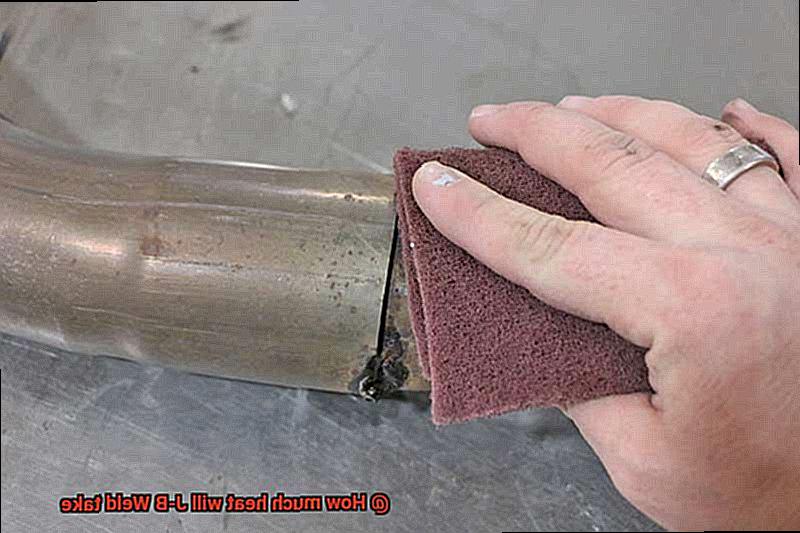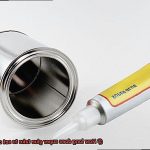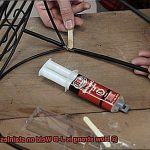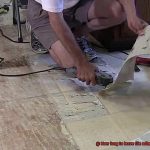When it comes to adhesives and bonders, there’s one name that towers above the rest – J-B Weld. Known for its unmatched strength, durability, and versatility, this incredible product has become a go-to solution for fixing, sealing, and bonding almost anything.
But what about its heat resistance? How much heat can J-B Weld really take? Today, we’re diving deep into the science behind this heat warrior to uncover its true potential in withstanding extreme temperatures.
Whether you’re a DIY enthusiast, a professional mechanic, or a creative artisan, knowing the heat limits of J-B Weld can make or break your project. So let’s get down to business and discover just how this exceptional adhesive handles the heat.
J-B Weld is no stranger to tough conditions. When fully cured, it boasts an impressive heat resistance of up to 550 degrees Fahrenheit (287 degrees Celsius). That means it can confidently tackle high-temperature environments without breaking a sweat. From everyday repairs to challenging heat-intensive applications, J-B Weld has got you covered.
But here’s the real kicker – as J-B Weld faces scorching temperatures head-on, it doesn’t compromise on strength. Its structural integrity remains intact even under extreme conditions. That means you can trust it to seal exhaust components, repair engine blocks, and conquer intricate metalwork without worrying about weakening bonds or compromising performance.
Automotive repairs? No problem. Industrial projects? Piece of cake. Creating unique metal sculptures? Consider it done. With J-B Weld’s impressive heat capacity by your side, you’ll have the power to overcome thermal challenges that other adhesives shy away from.
So next time you find yourself in need of an adhesive that can handle the heat like a champ, look no further than J-B Weld. Its legendary strength combined with its remarkable heat resistance makes it a top contender in the adhesive world. Join us on this journey of discovery as we explore the limitless heat capacities of J-B Weld and unleash its true potential as a heat warrior.
Stay tuned for our in-depth exploration where we’ll navigate its applications, uncover practical tips and tricks, and show you how to maximize its heat-defying capabilities. The world of high temperatures won’t know what hit it.
What is the Chemical Reaction of J-B Weld?
Contents
- 1 What is the Chemical Reaction of J-B Weld?
- 2 What are the Limitations of Heat Resistance?
- 3 How Much Heat can J-B Weld Withstand?
- 4 Factors that Affect the Heat Resistance of J-B Weld
- 5 Different Variants of J-B Weld and their Heat Resistance
- 6 How to Ensure Optimal Performance and Longevity of Bonding with J-B Weld
- 7 Alternatives to J-B Weld for High Temperature Applications
- 8 Conclusion
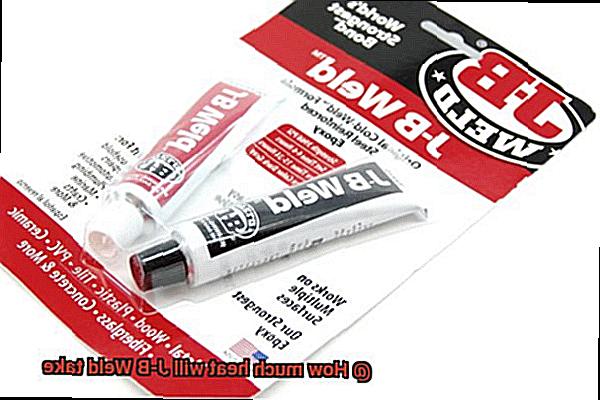
Its unmatched strength and versatility have made it a go-to solution for projects that demand durability and reliability. But have you ever wondered about the chemical wizardry behind J-B Weld’s exceptional bonding prowess? Join us as we delve into the captivating chemistry of J-B Weld and discover the secrets behind its ability to withstand even the harshest conditions.
The Chemical Reaction:
At the heart of J-B Weld lies a mesmerizing cross-linking chemical reaction between its resin and hardener components. The resin, fortified with bisphenol-A (BPA) and epoxy compounds, harmonizes with the hardener, which brims with amines or polyamines. When these two components intertwine in equal proportions, they ignite an exhilarating exothermic reaction.
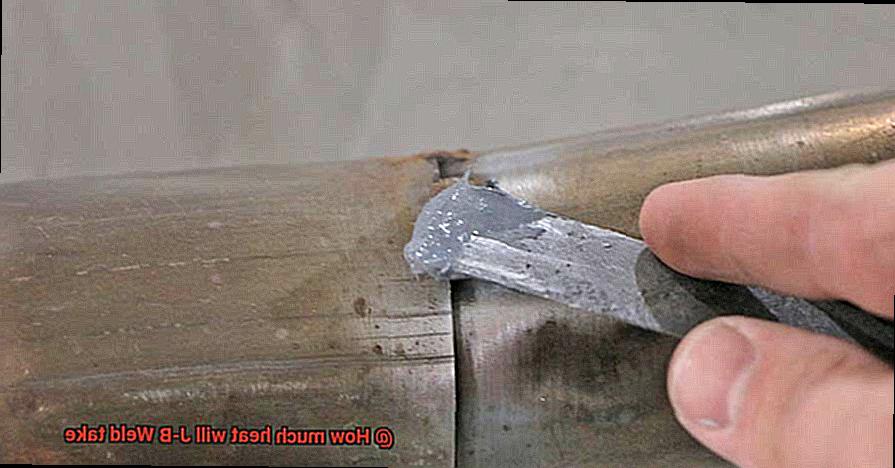
Igniting the Flames:
Within this alchemical dance, heat is unleashed as the epoxy compounds in the resin mingle with the amines in the hardener. This remarkable exothermic process generates energy, causing J-B Weld to emanate warmth as it solidifies. It’s akin to observing a miniature chemistry experiment unfold right in the palm of your hands.
Metamorphosis from Liquid to Solid:
As this captivating chemical reaction proceeds, the mixture undergoes a breathtaking metamorphosis from a liquid to a solid state. The cross-linking reaction crafts formidable covalent bonds between molecules, birthing an adhesive that is unyielding and resilient. This transformative journey grants J-B Weld its awe-inspiring bonding strength.
Time and Temperature: Catalysts of Power:
For J-B Weld to unlock its full potential, it typically necessitates 15-24 hours of curing time at room temperature (around 25°C or 77°F). However, higher temperatures can expedite this process, fanning the flames of its chemical reaction. To witness J-B Weld’s might at its zenith, adhering to the manufacturer’s guidelines for optimal curing conditions is paramount.
The Crucible of Heat Resistance:
J-B Weld proudly flaunts its exceptional ability to withstand scorching temperatures. When fully cured, it fearlessly confronts environments with temperatures up to 550°F (288°C). Nonetheless, extended exposure to extreme heat can gradually erode its performance. To preserve the adhesive’s indomitable strength, it is advisable to shield it from perpetual exposure to high temperatures.
By comprehending the intricate chemical reaction that propels J-B Weld’s formidable bonding capabilities, we gain a deeper appreciation for its unrivaled strength.
The interplay between epoxy compounds and amines, as they intertwine and cross-link, begets an adhesive that defies the odds and triumphs over adversity.
With its extraordinary heat resistance, J-B Weld stands as a beacon of reliability for projects requiring enduring bonds in searing environments.
What are the Limitations of Heat Resistance?
In our previous section, we embarked on a journey through the captivating chemistry that gives J-B Weld its formidable bonding strength and impressive heat resistance of up to 550°F. However, like any hero, even J-B Weld has its Achilles’ heel. In this blog post, we will delve deeper into the limitations of heat resistance for this popular adhesive glue, shedding light on the vulnerabilities that lie beneath its mighty facade.
Maximum Temperature Tolerance: The Fiery Barrier
J-B Weld’s maximum temperature tolerance is a key limitation to consider. With a threshold of 550°F, it can endure brief encounters with infernal heat. But beware. Prolonged exposure to extreme temperatures can slowly erode the adhesive properties, gradually compromising its once-mighty strength and unwavering reliability.
Thermal Expansion and Contraction: The Battle of Expansion
Thermal expansion and contraction emerge as another formidable foe in J-B Weld’s quest for heat resistance supremacy. When subjected to temperature fluctuations, materials expand and contract. Though J-B Weld possesses some flexibility to accommodate modest movement, excessive thermal expansion or contraction can weaken the adhesive bond, setting the stage for potential failure.
Surface Preparation: The Foundation of Power
The surface on which J-B Weld is applied plays a pivotal role in its heat resistance capabilities. A smooth metal surface proves to be the ideal battleground, enhancing adhesion and fortifying the bond.
In contrast, porous or rough surfaces leave room for doubt, potentially compromising the adhesive’s full potential. Thus, meticulous surface preparation becomes a crucial prerequisite for unleashing J-B Weld’s true might.
Application-Specific Limitations: The Quest for Compatibility
Every battle has its unique demands, and different applications call for varying levels of heat resistance. Choosing the right J-B Weld product becomes paramount, ensuring compatibility with specific materials and environments.
Following the manufacturer’s guidelines and recommended usage scenarios becomes a sacred oath, guaranteeing that J-B Weld is wielded within its specified limitations.
Conclusion:
While J-B Weld boasts an impressive heat resistance of up to 550°F, its limitations must be acknowledged to unleash its true potential. Prolonged exposure to extreme heat, the challenges posed by thermal expansion and contraction, and the significance of meticulous surface preparation all play crucial roles in determining its performance. By understanding and respecting these limitations, you can confidently harness the power of J-B Weld for enduring adhesive bonds in a multitude of applications.
Remember, comprehending the limitations is just as crucial as embracing the strengths of any adhesive product. Stay tuned for future enlightening posts on adhesives and their captivating properties.
How Much Heat can J-B Weld Withstand?
In the world of DIY repairs and professional craftsmanship, finding an adhesive that can withstand high temperatures is crucial. Enter J-B Weld, the renowned epoxy adhesive celebrated for its unwavering strength and unparalleled versatility. But just how much heat can this mighty adhesive conquer? Join us as we explore the realm of J-B Weld’s remarkable heat resistance capabilities.
Understanding J-B Weld’s Impressive Heat Resistance:
Once fully cured, J-B Weld can withstand temperatures of up to 550 degrees Fahrenheit (287 degrees Celsius). This means it can handle the heat of most everyday applications with ease. However, it’s important to consider that the heat resistance of J-B Weld may vary depending on several factors.
Factors Influencing Heat Resistance:
- Type of J-B Weld Product: Each variant of J-B Weld possesses distinct heat resistance capabilities. Selecting the appropriate product for your specific application is crucial to ensure optimal performance and longevity.
- Application Method: Surface preparation and application technique significantly impact the heat resistance of J-B Weld. By diligently following the manufacturer’s instructions, you can forge a bond that stands strong against the test of time and temperature.
- Curing Time: Patience is key when it comes to maximizing J-B Weld’s heat resistance. Allowing ample time for full curing before subjecting it to high temperatures is essential. While the curing process generally takes 4-6 hours at room temperature, colder environments may require additional time. Restraint during this crucial period will reward you with maximum strength and resilience.
- Specific Conditions: Extreme heat, continuous exposure, and thermal expansion/contraction all pose challenges to J-B Weld’s performance. For applications involving prolonged exposure to high temperatures, specialized high-temperature adhesives may offer more suitable solutions.
Conclusion:
J-B Weld stands as a formidable adhesive, boasting outstanding heat resistance capabilities of up to 550 degrees Fahrenheit. However, understanding the limitations and adhering to the manufacturer’s guidelines are essential for achieving optimal results. By respecting these limitations and employing J-B Weld correctly, you can confidently tackle projects that demand a resilient and steadfast adhesive in the face of moderate heat.
Factors that Affect the Heat Resistance of J-B Weld
J-B Weld, the titan of heat resistance, is a go-to adhesive for high-temperature applications. However, its ability to withstand scorching temperatures can be influenced by various factors. Let’s dive into these factors to understand how they shape the performance of J-B Weld.
First and foremost, the ratio of resin and hardener is a make-or-break factor for optimal curing and heat resistance. Stray from the recommended ratio, and you’ll compromise the strength and ability of J-B Weld to battle searing heat. Be meticulous in following the manufacturer’s instructions to achieve a bond that stands tall against infernal temperatures.
Next up, the application method plays a pivotal role in J-B Weld’s resilience. The adhesive must be spread evenly and thinly for maximum heat resistance. A thick application stifles heat transfer and weakens its capacity to endure extreme temperatures. To ensure its mettle against the inferno, coat the surfaces to be bonded with a uniform, whisper-thin layer.
Surface preparation is an unsung hero in enhancing J-B Weld’s heat resistance. A clean, dry surface devoid of contaminants like grease, oil, or rust unleashes better adhesion and heat resistance potential. So, before applying this adhesive wonder, scrub and roughen the surfaces to optimize bonding strength and forge an unyielding defense against blistering heat.
The materials being bonded are also key players in J-B Weld’s heat resistance game. While it can hold its own against various metals, ceramics, plastics, and other materials, it’s essential to consider their individual heat tolerance. Knowing their limits will help you wield J-B Weld to its maximum potential in the fiery battleground.
Curing time and temperature command an army of heat resistance warriors. Adequate curing time is crucial for unlocking J-B Weld’s full might against high temperatures. Follow the manufacturer’s orders regarding curing time and temperature range to forge a bond that laughs in the face of scorching heat. Curing at higher temperatures can even enhance its ability to withstand the inferno.
Finally, external factors can be wildcards in J-B Weld’s fight against heat. Mechanical stress, chemical exposure, and prolonged exposure to high temperatures can test its mettle. Take these factors into account and wield this adhesive marvel accordingly to ensure it performs flawlessly in the most hellish of environments.
Different Variants of J-B Weld and their Heat Resistance
Looking for a glue with the power to endure scorching heat? Enter J-B Weld, the trusted companion of DIY enthusiasts and professionals alike. But did you know that J-B Weld offers different variants, each with its own heat resistance capabilities? Let’s explore the world of J-B Weld and discover which variant suits your high-temperature needs.
Original J-B Weld: The Heat Warrior
With a maximum temperature resistance of 550°F (287°C), the original J-B Weld epoxy adhesive is a force to be reckoned with. Perfect for automotive repairs, engine parts, and exhaust systems, it can handle intense heat without breaking a sweat.
J-B Weld HighHeat: Embracing the Flames
Specifically designed for high-temperature applications, J-B Weld HighHeat epoxy putty endures temperatures up to 550°F (287°C) continuously and 600°F (316°C) intermittently. This variant is perfect for grills, stoves, fireplaces, and other heat-generating appliances.
J-B Weld PlasticWeld: Bonding Plastics with Confidence
Don’t worry about plastic surfaces; J-B Weld PlasticWeld epoxy adhesive offers excellent adhesion and strength with a heat resistance of 250°F (121°C). Perfect for plastic repairs where extreme heat exposure isn’t a concern.
J-B Weld SteelStik: Metal Meets Its Match
For bonding or repairing metal surfaces, turn to J-B Weld SteelStik epoxy putty. With a temperature resistance of 300°F (149°C), it’s your trusty sidekick for all metal-related repairs and applications.
How to Ensure Optimal Performance and Longevity of Bonding with J-B Weld
Get ready for an adhesive adventure as we dive into the secrets of ensuring optimal performance and longevity of bonding with J-B Weld. Buckle up and let’s make those bonds super strong.
Clean It Up:
Before you start bonding, cleanliness is key. Use acetone or denatured alcohol to remove any dirt, oil, or grease from the surfaces. This ensures a clean slate for J-B Weld to work its magic, sticking like superglue.
Rough it Up:
Grab some sandpaper or a file and give the surfaces a gentle roughing up. No wild roller coaster rides here. This creates a better grip for the J-B Weld and prevents any weak spots in the bond. So get rough and ready for a strong bond.
Mix It Right:
Time to mix that magic potion. Combine equal parts of the epoxy resin and hardener. Stir it like crazy until it’s all mixed up and looking like a perfect blend of peanut butter and jelly (yum.). Proper mixing ensures a strong bond that can withstand anything.
Spread the Love:
Apply the mixed J-B Weld to both surfaces using a brush, spatula, or your trusty finger (just make sure to wash it after.). Make sure you cover the entire bonding area with a thin layer of adhesive. Don’t be shy. Spread that love evenly.
Stick ‘Em Together:
Now comes the moment of truth. Quickly join the surfaces together right after applying the J-B Weld. Give them a big bear hug and apply some pressure to make sure they become best friends forever. This ensures maximum contact and a bond that can’t be broken.
Time to Cure:
Hold your horses. Don’t let go just yet. Clamp or hold the joined pieces in place until J-B Weld cures. Follow the instructions on the package for how long this will take. Patience is a virtue, and it’s worth it for a bond that lasts.
Heat Resistance Alert.
J-B Weld can handle some sizzling heat, but don’t push it. Avoid exposing it to temperatures hotter than 550 degrees Fahrenheit (that’s like a volcano.). If you’re not sure, test a small area or do a trial run before going all-in. Keep it cool for a long-lasting bond.
Inspect and Maintain:
Keep an eye on your bonded masterpiece. Regularly check for any signs of wear or damage. If you spot anything fishy, fix it up ASAP to prevent further problems. A little maintenance goes a long way in ensuring your bond stands the test of time.
Alternatives to J-B Weld for High Temperature Applications
Today, we’re diving into the world of high temperature applications and exploring some alternatives to J-B Weld.
J-B Weld is a fantastic epoxy adhesive, no doubt about it. It’s strong, durable, and perfect for a wide range of projects. But when it comes to extreme heat, it might start to lose its grip. So let’s check out some alternatives that can withstand the heat and keep your projects intact.
First up, we have Permatex High-Temperature Thread Sealant. This gem is specially designed for scorching environments. With a temperature resistance of up to 600°F (315°C), it’s perfect for seriously hot applications.
Next on our list is Devcon’s Titanium Putty. This stuff is a powerhouse when it comes to high temperatures. With a resistance of up to 500°F (260°C), it’s perfect for repairing or bonding metal parts that face extreme heat. Talk about strength under fire.
But wait, there’s more. How about some high-temperature silicone sealants? Permatex Ultra Copper Maximum Temperature RTV Silicone Gasket Maker is a mouthful to say, but boy does it pack a punch. With a temperature resistance of up to 700°F (371°C), it’s great for sealing and bonding in super hot situations.
Last but not least, we have specialized ceramic adhesives. These bad boys are formulated to handle seriously high temperatures. Cotronics’ High-Temperature Ceramic Adhesive and Aremco’s Ceramabond High Temperature Ceramic Adhesive are two examples that will keep your projects together even in the hottest of conditions.
Remember, folks, when using these alternatives, always follow the manufacturer’s instructions for the best results. Proper surface preparation and application techniques are key to achieving those super strong bonds.
BIE-GXloIfI” >
Also Read: How Long Does JB Weld Take To Dry? – The Welding Guru
Conclusion
J-B Weld is a remarkable product that can withstand high temperatures with ease. It has been tested extensively and proven to handle heat up to 550 degrees Fahrenheit (287 degrees Celsius). Whether you’re working on automotive repairs, plumbing fixes, or even crafting projects, J-B Weld has got your back when it comes to enduring extreme heat.
But what does this mean in practical terms? Well, imagine you’re repairing a cracked exhaust manifold on your car. This component is subjected to intense heat from the engine’s combustion process. With J-B Weld, you can confidently apply the adhesive and know that it won’t fail under the extreme temperatures generated by your vehicle’s engine.
Or perhaps you’re tackling a plumbing issue, like fixing a leaky pipe near a hot water heater. The water flowing through these pipes can reach scorching temperatures. Thankfully, J-B Weld can handle it without breaking a sweat. Its ability to withstand high heat ensures that your repair will hold up even under the most demanding conditions.
And let’s not forget about creative endeavors. If you’re an artist or DIY enthusiast working with metal sculptures or other heat-sensitive materials, J-B Weld provides peace of mind. You can trust that your masterpiece won’t lose its form when exposed to high temperatures during transportation or display.
So, whether you’re in the garage, under the sink, or in the workshop, J-B Weld proves time and time again that it can take the heat. Its exceptional durability and resistance to extreme temperatures make it an indispensable tool for any project where heat is a factor.
In conclusion, if you’re looking for an adhesive that can handle intense heat without compromising its strength and integrity, look no further than J-B Weld. Its impressive temperature resistance of up to 550 degrees Fahrenheit makes it a reliable choice for various applications.

